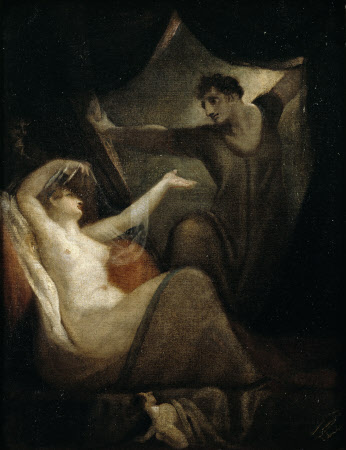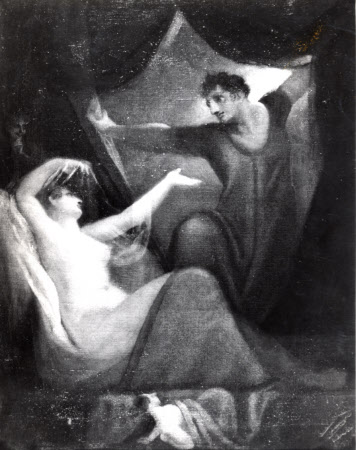A Scene from 'The Wife of Bath's Tale' (from Geoffrey Chaucer's, 'Canterbury Tales') (recto); Falstaff in the Laundry Basket mocked by Five Women (?) (verso)
Henry Fuseli (Zurich 1741 - London 1825)
Category
Art / Oil paintings
Date
circa 1812
Materials
Oil on canvas
Measurements
908 x 686 mm (35 ¾ x 27 in)
Place of origin
England
Order this imageCollection
Petworth House and Park, West Sussex
NT 486148
Caption
This painting probably represents the climax of the ‘Wife of Bath’s Tale’ from Chaucer’s ‘Canterbury Tales’. The knight has been forced into marriage with the old hag who had saved his life. He draws back the bed curtains, to reveal her transformation into a young and beautiful girl. Possibly the form under the bed represents the old woman before her metamorphosis. The existence of a composition on the back of the canvas, hidden beneath a layer of orange paint, was revealed when the picture was restored in 1957. It shows a group of five women, either unfinished or with half the area of paint missing as a result of damage. The women stand together, laughing and smiling. The elaborate and bizarre dressings of their hair, suggesting Egyptian fashions, perhaps derive from Fuseli’s studies of Roman portrait busts. It seems probable that it was an obscene image, hence its having been scratched out.
Summary
Oil painting on canvas, A Scene from 'The Wife of Bath's Tale' (from the Chaucer's 'Canterbury Tales') (recto) and Falstaff in the Laundry Basket mocked by Five Women (?) (verso) by Henry Fuseli (Zurich 1741 - London 1825), circa 1812. A scene from Chaucer's 'Wife of Bath's Tale' showing a woman reclining, left, with a man in the background holding apart the curtains.
Full description
Henry Fuseli (1741-1825) was born in Zurich. His father was a painter and art historian, who forced him to become a clergyman and he was ordained in 1761, but his exposure of a dishonest magistrate ended his career as a Zwinglian minister. In 1763 he began studying art in Berlin and later came to England to work as a hack translator of French, German and Italian books and occasional illustrator. He was encouraged by Reynolds to become a painter and in 1770 he went to Rome for eight years where he taught himself. On his return to England he began exhibiting works of imaginative power. He worked for Boydell's Shakespeare Gallery, and was made Professor of Painting at the Academy in 1799 and Keeper in 1804. He had to resign as Professor in 1805, but the statutes of the RA were altered in 1810 to allow him to hold both posts, in spite of the inadequacy of his technical knowledge. Among his pupils were Haydon, Leslie, Constable and Landseer. He became an ARA in 1788 and an RA in 1790. visited Italy, 1770, exhibited R.A. 1774-1825; B.I. 1806; elected A.R.A. 1788; R.A. 1789; died at Putney in 1825., Catalogue of the Petworth Collection of Pictures in the Possession of Lord Leconfield by C. H. Collins Baker, London, The Medici Society Ltd. 1920. p. 46. George O'Brien Wyndham, 3rd Earl of Egremont (1751-1837) was the son of Charles Wyndham, 2nd Earl of Egremont (1710-1763) and the Hon. Alicia Maria Carpenter (1729-1794). When still a schoolboy at Westminster he succeeded to the Earldom at the age of twelve in 1763 when his father died aged 53. In 1784, the fifteen-year-old Elizabeth Iliffe bcame his principal mistress and the unofficial chatelaine of Petworth. She was the daugher of a Westminster schoolmaster and bore Egremont seven children before their marriage in 1801., This probably represents the climax of the 'Wife of Bath's Tale' from Chaucer's 'Canterbury Pilgrims'. The knight has been forced into marriage with the old hag who had saved his life. He draws back the bed curtains to reveal her transformation into a young and beautiful girl. Possibly the form under the bed represents the old woman before her metamorphosis. The puckish figure behind the pillar is perhaps connected with the Wife of Bath's references to the fairies who were abroad in the time of King Arthur., On the back of the canvas is a composition whose existence was revealed when the picture was restored in 1957. It shows a group of five women, either unfinished or with half the area of paint missing as a result of damage. The women stand together, laughing and smiling. The elaborate and bizarre dressings of their hair suggesting Egyptian fashions, perhaps derive from Fuseli's studies of Roman portrait busts. A drawing in the Fogg Museum, Cambridge, Massachusetts, of 'Two Courtesans' recalls the head of the girl who is second from the right in NT/PET/P/50. Similar exotic head-dressing occurs in a drawing by Fuseli, again of 'Two Courtesans' in the Auckland City Art Gallery (exhibited Royal Academy Winter Bicentenary Exhibition, 1968, no. 657, which is dated c. 1796-1800)., Green Folder, 1-99
Provenance
In the collection of the 3rd Earl of Egremont (1751-1837) by 1835; thence by descent, until the death in 1952 of the 3rd Lord Leconfield, who had given Petworth to the National Trust in 1947, and whose nephew and heir, John Wyndham, 6th Lord Leconfield and 1st Lord Egremont (1920-72) arranged for the acceptance of the major portion of the collections at Petworth in lieu of death duties (the first ever such arrangement) in 1956 by H.M.Treasury.
Credit line
Petworth, The Egremont Collection (National Trust)
Makers and roles
Henry Fuseli (Zurich 1741 - London 1825), artist


